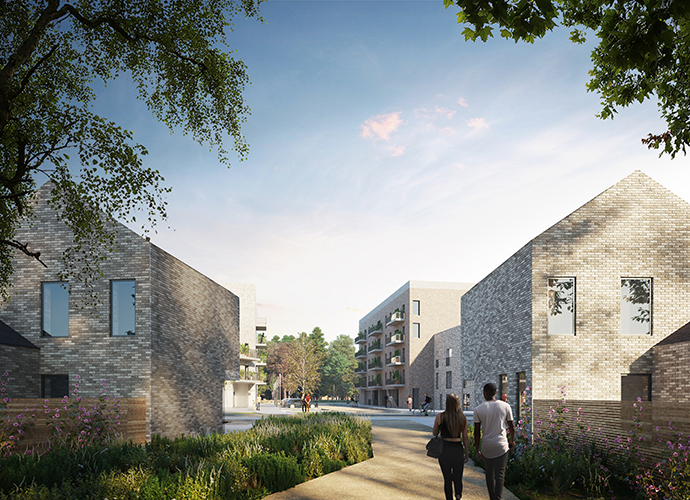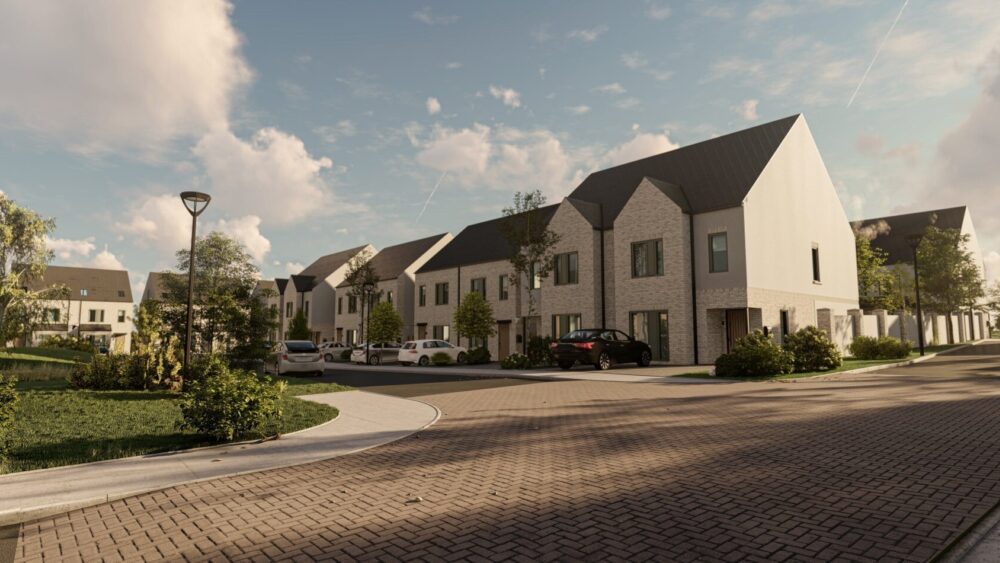LDA chief John Coleman sets out plans to ramp up housing delivery

Land Development Agency CEO John Coleman tells Robbie Cousins that the state residential development agency now has the right strategies in place to increase housing delivery and will be well placed to pick up fall-off in building activity in other sectors.
Land Development Agency
The Land Development Agency (LDA) was formed in late 2018 to manage and optimise land in state ownership with a specific emphasis on delivering affordable and social homes.
The agency was placed on a statutory footing in 2021, which set out its core objectives and powers in law as well as its primary function ‘to develop and manage relevant public land and, where applicable, other lands for the provision of housing for the public good’.
It has been delivering homes through two channels to date – by direct delivery on state-owned lands and through the forward purchase of as-yet unbuilt developer-built homes through Project Tosaigh.
In June of this year, a third pipeline was added when the agency announced that it would be seeking to acquire privately owned sites with planning consent that could be utilised for quick delivery of public housing.
This comes at a good time for the sector, as investment funds, which have been driving activity in the private rental sector (PRS), have cooled their activity somewhat, freeing up contractor capacity for the agency to directly engage and build its projects.
In March, the LDA presented the government with a document that listed all available state-owned lands. This report estimated that in the 10 main urban centres of Ireland, including the main cities, about 67,000 homes could be delivered on lands over the short, medium and long term.
John Coleman
LDA CEO John Coleman says the agency aims to deliver at least 10,000 units in the next five years.
He explains, “We have planning permission for more than 3,500 homes on state-owned lands with many projects already under construction, including 597 homes on our Shanganagh site in south Dublin; 265 at St Kevin’s Hospital in Cork; more than 800 homes in Balbriggan, Co Dublin, and 543 at St Teresa’s Gardens in Dublin’s south inner city in partnership with Dublin City Council.
“We are well placed to pick up the slack should there be any drop off in the private development of housing and commercial development. This means we can provide another strong pipeline of work for contractors large and small with our plans for the rest of the decade.”
John Coleman says that the complexity of acquiring land has hindered some of its work to date, but the agency is now picking up momentum and will continue to do so. “We have been acquiring lands owned by other land-owning state bodies. We are now also entering into what are essentially joint ventures with housebuilders through Project Tosaigh, which are commercial arrangements that underwrite apartment delivery, which would not have otherwise happened.
“We are also involved in longer-term strategic state land assembly projects, which operate on a larger scale and may require significant infrastructure. We need to start unlocking these landbanks, as it will take time. One example is Colbert Station in Limerick, where about 50 hectares of state land is shared by the HSE, Irish Rail and the local authority. We are stitching these plots together to form a much larger, more cohesive master plan development. We’ve released a master plan for Colbert, and we will prepare the first planning applications later this year, which brings a sense of reality to these major projects.”
LDA delivery targets
John Coleman says the agency aims to deliver 10,000 homes over the coming five years.
“We’re aiming to deliver at least 10,000 affordable homes over the next five years, as well as unlocking more state lands for development. Our overarching delivery target is roughly 50/50 between direct delivery on state lands and through Project Tosaigh.”
With additional finances, it is estimated the agency could ensure a pipeline of nearly 2,000 affordable homes a year from 2026.
He adds, “We are in discussions with the government about reviewing our business plan at the moment. So, that might change or even increase from the level of output we are aiming for.”

Land acquisition
“The study of available landbanks we presented to the government in March was a useful exercise because, for the first time, we have a clear picture of what state land has potential for housing. It should be noted not all lands are available because there may be future plans or existing operational uses for facilities that are not easily relocated, such as hospitals, bus depots or ports, etc.”
Local authorities are the main bodies that hold land for housing purposes, and they have been the key target for partnerships with the LDA, as local authorities want land in their ownership to be developed for social and affordable housing.
Coleman explains, “Most state bodies that own land have been working well with us, and they are pragmatic in so far as they are trying to maintain their own services, such as transport, but they are also trying to facilitate development. Dun Laoghaire- Rathdown Council and the Shanganagh project of nearly 600 homes is a prime example of how collaboration between local authorities and the LDA can deliver.
“While it will take time, we will continue to add to our landbank from state bodies. Even when we get access, bringing it through design, the planning system, and procurement will take time. But this does not mean it shouldn’t be done. These schemes are starting to deliver. We are working away on continuing to grow our project pipeline of state lands and not taking our eye off it.”
Coleman is acutely aware of the short-term urgency of delivering new social homes.
“We are very much focused in terms of the resources that we have on developing sites that we already have access to. On the direct delivery sites, of the 5,000 we have put into planning, about two-thirds have planning consent. These projects are in development or can be developed in the coming months.”
Private land acquisition
As the LDA can’t get planning consented state land fast enough to deliver on its objectives, it is undertaking an increasing amount of developer-led delivery.
“We want to and will increase the direct delivery element of work in the coming years. To that end, we need the raw material of land. Coleman comments. “The land market has changed and is not quite as strong as it was. Given increased interest rates, there’s not as much money chasing land. The institutional private rental sector has, it would appear, temporarily paused. So, it is not a bad time to see if we could acquire land with planning consent or near planning consent in the market to accelerate our direct delivery programme. So, we’ve gone to the market. We’ve received expressions of interest, and we’re reviewing these at the moment. But we’ll only proceed if we can get value.”
He elaborates, “To give you a sense of what value might look like in our eyes, we’re closing out a deal with NAMA at the moment to acquire land with sites for 2,500 homes in Clongriffin. It’s been reported that the landbank has a value of around €45m. This would mean a price of about €20,000 per unit of land value. If it costs over €400,000 to deliver an apartment, the land isn’t a massive piece of the pie. If we can get similar good value in the market in a way that helps us keep the delivery costs down and rental costs down as a result, I think we will look to make additional acquisitions if we can get that value.
“Our objective with Clongriffin would be to appoint a builder to develop the first couple of blocks, comprising about 500 homes, as soon as possible. We aim for that to happen next year.”
- “We’re aiming to deliver at least 10,000 affordable homes over the next five years and unlocking more state lands for development. Our overarching delivery target is roughly 50/50 between direct delivery on state lands and through Project Tosaigh.” John Coleman.

Judicial reviews
Only one of LDA’s seven direct delivery schemes to date has been brought to judicial review.
Coleman says, “The development of the former Dundrum Central Mental Hospital site is currently pending. We’re waiting to see what the court says about that when it’s heard in October.
“We fend off judicial reviews by having advanced consultation and working out any concerns people in the immediate neighbourhood and community might have. We invest a lot of time in this part of the planning process, and we can’t complain too much as we’ve got seven reasonably large planning applications lodged to date, and six of these have proceeded without judicial review.
“For Dundrum, we consulted extensively with the local community. We always want to speak with people who have concerns instead of dealing with issues through the courts. I think it’s in no one’s interest to burn up legal fees this way. Often, there are pragmatic solutions available. The reality is that judicial reviews are always a risk. We wish that risk wasn’t so prevalent.
Skills gap
Capacity has been an issue for everyone, including the LDA, which currently employs around 100 people and plans to double or even triple this number.
John Coleman comments, “From our perspective, if capacity is freed up in the market, we can work with more contractors. There are many good contractors in this country that we’d love to work with. So, if there’s any freeing up of capacity to work on our sites, we’re very much all for that.”
He adds, “While skills shortages affect us indirectly if contractors have a lack of capacity to take on work in busier times, it also affects us directly. We need to hire staff too. We’ve just over 100 staff at the moment. We plan to at least double and potentially triple that number in the next few years.
“The LDA is a dynamic organisation. We are in the early stages of a very exciting development programme in the next 10 years. We are offering the right people with the right skills and experience an opportunity to be part of reshaping housing delivery in this country.”
Building costs
Despite being highly capitalised, inflation has impacted the LDA’s original programme, but it has also enabled it to show its ability to adapt to meet new circumstances.
“Inflation has had a profound impact on us. When the LDA was formed in 2018, the cost of delivering a house was about 25% less. The economics around affordable rental delivery for apartments was always very tight. It’s very difficult to cover costs while producing affordable prices for occupiers. Rising inflation has fundamentally changed the economics behind cost rental, which now needs support. Thankfully, the government has been able to step in and provide support by way of the Secure Tenancy Affordable Rental or STAR scheme. This government support has meant that we’re well capitalised, and I don’t see inflation as a factor that will slow down our delivery programme.
“Furthermore, If there is a fall-off in private sector delivery, this is when you want the state to step up and do more, and that is what is happening at the moment.”
Developer framework
John Coleman comments that at its outset, the LDA would have been seen by some developers as a competitor. But, how it has evolved means that the relationship with developers is much more collaborative, and its new developer framework will bring that relationship to a new level.
“There are a couple of ways that we can work with developers. Firstly, we can underwrite their scheme by agreeing to purchase from them at a fixed price in the future. That often means they can get finance and deliver the schemes with their exit risk removed.
“Finance has become more expensive and harder to get. The way we have worked with developers to date has not involved a procurement process because we have been purchasing completed properties, which are not subject to public procurement.
“We will now deal with this in a more efficient way by procuring a panel of developers,” he explains. “We’re currently prequalifying a panel and will have that panel procured by December. The intention is then to call off deals from that panel. For instance, we go to the panel and say we want 1,000, 2,000 or 3,000 homes in specific locations of a particular specification in the following timeframes, with an understanding of what’s possible from the panel by engaging in advance on a collaborative basis.
“This would be a much freer way for us to deal with developers as we can offer stage and milestone payments. I think that will be of interest to the developer sector, and it would reduce their financing needs.
“We’re also open, through the framework, to looking at developers building on sites we may have if that’s the most efficient way. This would make for a very fruitful and collaborative relationship.”

Contractor relationships
The LDA wants to work with contractors of all sizes on its direct development sites. The agency doesn’t have a contractor framework at the moment; it procures on a project-by-project basis. But John Coleman says it is open to changing the dynamic.
“We are working very well in collaboration with some excellent contractors, for instance, Walls Construction on Shanganagh. We view ourselves very much as being in partnership with contractors. From a funding perspective, it makes perfect sense. The LDA is fully funded, so contractors can have full confidence in our resolve to proceed with the deal, given the chronic need for housing.”
He adds, “If it makes sense, especially as our bank of developable land builds, we may form a contractors panel in the future. But only when and if the time is right.”
SME contractors
While the LDA hasn’t publicly released the results of the latest two procurements it has completed for the Saint Kevin’s Hospital in Cork and Devoy Barracks in Naas, it will be contracting SME contractors who are right for the jobs
John Coleman says that the scale of the project dictates the size of the contractor that works on it, and the agency is very much open to working with SME contractors.
“We’ve always consulted with the market in advance about our procurement for contractors to understand what we want. When we have more projects on site, we will not only have tier-one contractors but a broad range of SME contractors as well. It’s a matter of horses for courses on our projects, and we will have a wide variety of projects.”
Shanganagh
The LDA currently has three direct delivery projects on site, totalling about 1,000 homes, the largest of which is Shanganagh.
“Shanganagh is progressing very well. We will have the first 280 homes delivered next year. The scale of Shanganagh is staggering. At 597 homes in one go, it is the biggest social housing project in the country. We’re very happy with how this has gone to date, and we have an excellent collaborative relationship with all stakeholders.”
LDA challenges
John Coleman reiterates that the key challenges that lie ahead for the LDA are getting access to well-designed consented land and securing the capacity to deliver.
“At the moment, we are either bringing projects through the planning process or acquiring land on the market. It’s important to understand, however, that not all land that has planning consent is equal. One site might be much better designed or have better services than another. This has a significant bearing on delivery costs and buildability.
“We are also watching the capacity in the market to provide housing through developers or directly with contractors. And, as we build up our direct contracting work, we will need to bring on more people within LDA, which presents a scaling challenge.”
Modern methods of construction
Finally, looking to the future, John Coleman stresses that the LDA wants to work with anyone who will help it deliver homes quickly, and he cites modular and modern methods of construction (MMC) as having the potential to be a major contributor to this in the coming years.
“We want to work closely with anyone who can help us get on site and build quickly and efficiently. We are looking at MMC at the moment. This will be important in the coming years. We are carrying out a lot of work on standardisation of design at the moment, and this would facilitate the use of MMC. Modular and MMC will be important, particularly if they can speed up delivery. But for the moment, our focus is on cementing relationships with developers and contractors and expanding our landbanks across the country to ensure continuity of supply,” John Coleman concludes.


